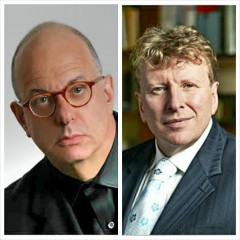|
Back
The Other Side of Pax Britannica New York
Isaac Stern Auditorium, Carnegie Hall
01/31/2014 -
Sir Arthur Bliss: Suite from Things To Come
Frank Bridge: Phantasm for Piano and Orchestra
Robert Simpson: Volcano
Sir William Walton: Symphony No. 2
Piers Lane (Piano)
American Symphony Orchestra, Leon Botstein (Conductor and Musical Director)

L. Botstein, P. Lane (© J. Sherman/Keith Saunders)
Never predict what Leon Botstein and the American Symphony Orchestra can offer an audience. A program devoted to relatively unknown 20th Century British composers should have aroused listeners to a) stare at SuperBowl television previews; b) prepare for two hours of muffled yawns; or c) go somewhere else. Anywhere else.
Instead, while two of the four works played last night were impressive enough, the other two were major–major–revelations.
My only acquaintance with Robert’s Simpson’s Volcano and Frank Bridge’s Phantasm had been on YouTube in the afternoon, where my curiosity was piqued. Yet I had no idea that they would have such Gargantuan impact in Carnegie Hall.
I knew Bridge as Benjamin Britten’s teacher, and as a very proper composer of Brahmsian tunes. With the first notes of Phantasm, a one-movement work for piano and orchestra, I was transfixed. The piece begins in the shadows of some low rumblings, but continues with manic piano playing, orchestral tuttis, shadowy figures for both groups, and strange wanderings into distant keys. Yes, it ends in those same shadows, but in the meantime, this was a Notre Dame Cathedral of evil ornamentations, Gothic figures and non-stop piano legerdemain.
Piers Lane, the soloist, has about 90 concertos under his belt, and this didn’t frighten him at all. His fingers whisked about the keys, roaming in all directions at once, for this is a work for a grand technician. And while 25 uninterrupted minutes might seem fairly long, Frank Bridge, who was accused of “uglifying” his genteel music in 1932, actually had much to say in his arcane language. The structure was complex, but the architecture and sounds kept the attention.
As for Robert Simpson, I had known him mainly as a devotee and exponent of Jean Sibelius and Carl Nielsen. I had heard his symphonies, and found them gigantic, lumbering, hammered together craftily but inferior to those Nordic composers.
Volcano was a different story. Think of the ensemble. A huge brass group, taken from the American Symphony Orchestra, with the rarest instruments. A soprano cornet, nine B-flat cornets, alto horns, baritone horns, tenor and bass trombones, four tubas etc etc. Then a large percussion ensemble. And then a ten-minute score embracing the most piercing colors, excitement and volcanic music.
There was no way to classify Volcano. Parts could easily have come from Varèse’s Octandre (though there were too many nice cadences), parts seemed to quote the most extreme “battle” movement from Strauss’s Heldenleben. But the high-pitched cornets kept on playing, while Strauss’ brass had toned down their shrieks.
Two other works were more familiar, but they each had their moments. Sir Arthur Bliss’ music for Things to Come, a 1936 sci-fi film, was better than the movie (though that film is watchable even today.) Listening to Mr. Botstein conduct, I saw, though, that this was not hybrid music by tri-brid music.
Most of it stemmed directly from Georges Auric and the other French composers who had melded the films of René Clair and other French filmmakers. France had always seen music as part of the film, not simply background (as in America and Great Britain), and Bliss took advantage of this. Second was Soviet music, especially in the “Machine” section. This was Russian futurist music, the literal pounding of Mosolov and his kin.
Third, inevitably, was Bliss the Briton, ending with an Elgarian march, the kind to which I began to append patriotic words in my mind.
The final work in this all-British program was Sir William Walton’s bright, brassy, brilliantly orchestrated Second Symphony. Here, Mr. Botstein’s orchestra didn’t quite rise up to the task for the first movement. Nothing wrong technically, but Walton’s music, no matter what the substance, has multiple collops of color, and this lacked the requisite snappiness, pushing glosses into plaids. The second movement oozed impressionism, verged on Messiaen harmonies, but the effect was pallid.
The final movement mollified the beginning. This was Walton’s successful attempt to make dodecaphony penetrable, with easy variations on the opening tone row. Here, in an orchestral concerto ending, soloists and consorts had their own parts of play, and all of it, including that jazzy fugato, was given a sensitive, and resolute reading–thankfully without even a perfunctory salute to Pax Britannica.
Harry Rolnick
|